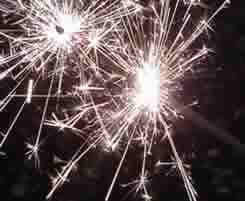
A chemical reaction is irreversible and produces something new. It involves reactions at the molecular or atomic levels. Chemical reactions involve the collision of reactant molecules or atoms. During chemical reactions molecules break apart and recombine to form new products. The same atoms that were present before the reaction are present after the reaction, just combined differently with other atoms. In this way no mass is lost or gained during a chemical reaction. This new product can be a gas, heat, electricity, just to name a few. It is not always easy to identify a chemical reaction but a few clues do exist. A colour change, sound, bubbling are just a few ways that may indicate a chemical reaction. There are many different types of chemical reactions and below are just some that we can introduce you to.
Take the formation of sodium chloride, common table salt. It is an essential dietary requirement. Salt is formed from a deadly gas, chlorine and a very reactive metal known as sodium. Chlorine was used during WWI as a chemical weapon while sodium reacts explosively with water. This shows that the products of chemical reactions can have totally different properties from the reactants that formed them.
A chemical reaction occurs when normal cotton wool is soaked in concentrated sulfuric and nitric acids. View the video on the right. Normal cotton wool is burnt on the left.
How have the properties of the cotton wool changed?
This new compound is known as guncotton.
Why was guncotton used to propel projectiles from cannons?
Some students confuse physical change with chemical reactions. The starting and ending materials of a physical change are the same, even though they may look different. Examples of physical change include crushing salt, melting ice or dissolving sugar. In every case the starting materials are the same as the materials at the end. They just look different.
Chemical reactions are all around us. From the kitchen to the car, we encounter a multitude of chemical reactions which are both life sustaining and a source of entertainment. The world is full of chemical reactions, all we need to do is identify them.
One of the most
important chemical reactions is that of photosynthesis. This reaction can be described by the word equation below.
Carbon dioxide + water + sunlight ==> sugar + oxygen
Plants use the energy from sunlight to combine carbon dioxide and water
in order to produce sugar and oxygen. This sugar is used by plants and
animals as food and without this reaction no life would exist on Earth.
A number of demonstrations and experiments can be conducted in the classroom to give an appreciation of the variety of chemical reactions that take place.
Click on the topics below to see just a few of the many activities available
The
serpent
Making
money increase in value.
Making a home battery.
The bouncing ball
Colourful
solids
Making metals from solutions
Production and use of hydrogen gas
Burning metals
- sodium (400kb video)
- magnesium(120 kb video)

Sparklers give off light and heat as the metals that form them rust rapidly and irreversibly.
Click to go to an activity to make home made sparklers.
The activity on the right produces a great deal of oxygen gas and gives off heat in the irreversible process.
Click on the "The serpent" above to go to the activity and see the video. Ask your teacher to demonstrate this.
Look at the reaction on the right. What indicates that a chemical reaction takes place? Give two observations
1)
2)
It is not always easy to see the new product formed during a chemical reaction. Some chemical reactions produce electrical energy. These reactions are used to power lights and other electrical appliances. Batteries use these special type of chemical reactions to produce useful energy.
Click for more information about chemical reactions producing electrical energy.
Special conditions must exist if a chemical reaction is to take place.
Firstly the right reactants must be present. When petrol burns in the engine of a car it does so because petrol and oxygen have been mixed together. No reaction will occur if pure petrol is used without oxygen.
Secondly, most reactions need energy before they proceed. A mixture of petrol and oxygen will remain indefinitely without reacting unless a naked flame or spark is introduced. This naked flame provides the energy necessary to get the reaction started. The energy necessary to start the reaction is known as activation energy .
Click
to see a 120kb video of hydrogen reacting with oxygen in the "pop
test". What special conditions are necessary for this reaction
to proceed?
Explain what will happen if a flame was placed in a sealed container
full of pure hydrogen gas.
A number of
reactions take place every day around the home.
Continue
with a discussion of some simple chemical reactions around the home.
Look at the video on the right. It shows magnesium reacting with hydrochloric acid.
1) What is produced?
.
How can you tell?
2) What is one of the products?
How can you tell that it was this product?
3) When a flame is brought close to the test tube a loud explosion is heard. The flame provides energy to the reactants in the test tube. This energy is known as
4) The energy discussed in question 3) above causes
All chemical reactions can be expressed as chemical equations. We have devoted a special section on chemical equations because they represent a very important aspect of chemistry.
Continue with collision theory
Continue with some simple exercises
Continue to see how some atoms react with each other to share or give electrons.